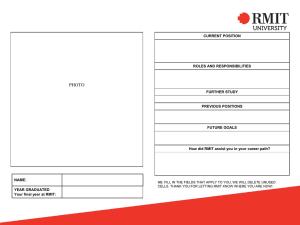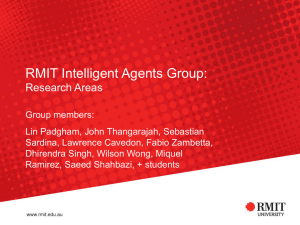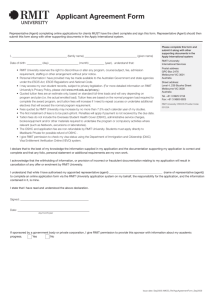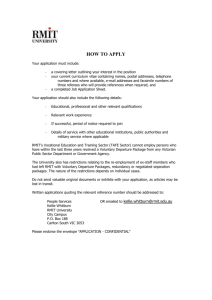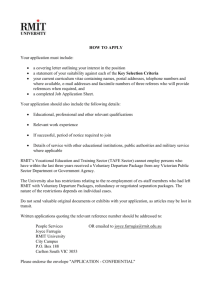attachment 1 - RMIT University
advertisement
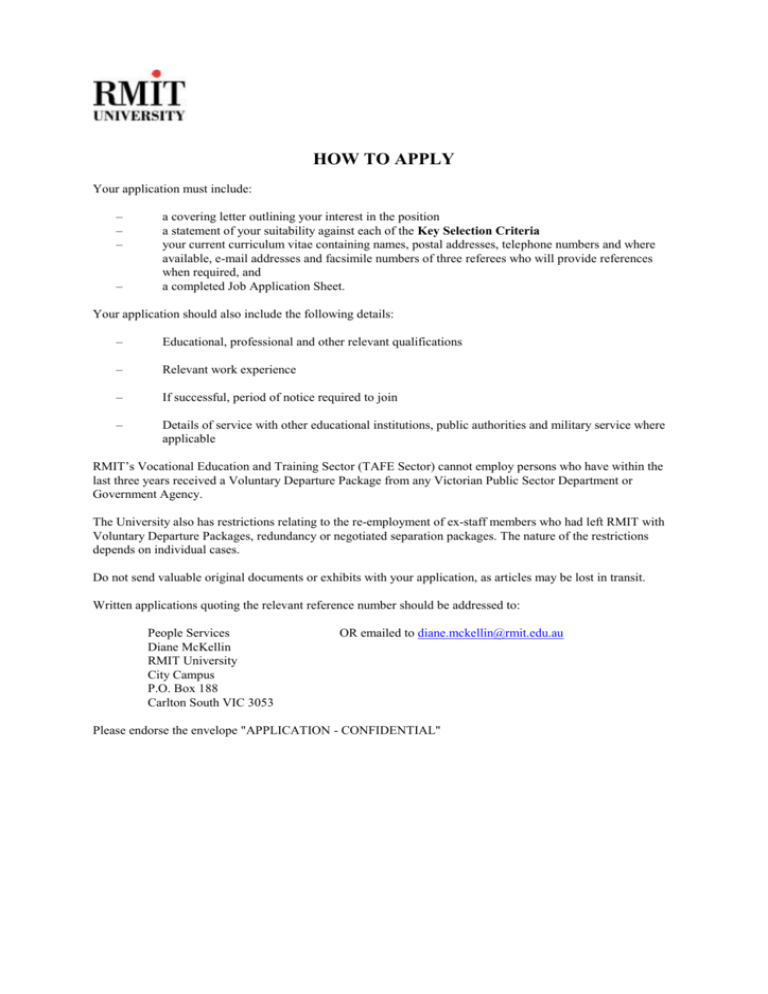
HOW TO APPLY Your application must include: – – – – a covering letter outlining your interest in the position a statement of your suitability against each of the Key Selection Criteria your current curriculum vitae containing names, postal addresses, telephone numbers and where available, e-mail addresses and facsimile numbers of three referees who will provide references when required, and a completed Job Application Sheet. Your application should also include the following details: – Educational, professional and other relevant qualifications – Relevant work experience – If successful, period of notice required to join – Details of service with other educational institutions, public authorities and military service where applicable RMIT’s Vocational Education and Training Sector (TAFE Sector) cannot employ persons who have within the last three years received a Voluntary Departure Package from any Victorian Public Sector Department or Government Agency. The University also has restrictions relating to the re-employment of ex-staff members who had left RMIT with Voluntary Departure Packages, redundancy or negotiated separation packages. The nature of the restrictions depends on individual cases. Do not send valuable original documents or exhibits with your application, as articles may be lost in transit. Written applications quoting the relevant reference number should be addressed to: People Services Diane McKellin RMIT University City Campus P.O. Box 188 Carlton South VIC 3053 OR emailed to diane.mckellin@rmit.edu.au Please endorse the envelope "APPLICATION - CONFIDENTIAL" JOB APPLICATION SHEET PLEASE COMPLETE ALL DETAILS LISTED BELOW AND EMAIL THIS SHEET WITH APPLICATION TO diane.mckellin@rmit.edu.au or post to the address below. Reference No Position Title Family Name Title Given Name(s) Home Address Postcode State Email Address Telephone Home Work Citizenship Resident Status if not Australian APPLICATIONS ADDRESSED TO People Services Diane McKellin RMIT University City Campus PO Box 188 Carlton South Vic 3053 or email to diane.mckellin@rmit.edu.au FOR PEOPLE SERVICES USE ONLY HR system updated and acknowledgement sent Date Initial POSITION DESCRIPTION 1. POSITION SUMMARY Position Title: Position Number: Time Fraction: Tenure Status: Classification: Salary Range: Division Faculty/Group/School: Department/Branch: Campus Location: 2. Senior Lecturer TBA Full time Continuing Level C $62,608 - $72,192 Engineering School of Electrical and Computer Engineering Based at the City campus, but may be required to work at other campuses of the University THE UNIVERSITY RMIT University is a multi-level dual sector education, training and research service organisation, offering programs ranging from certificate level vocational programs through tailored programs for industry and community clients, to post-graduate research programs. The University has several companies which are responsible for commercial activities relating to the University’s core functions. The University’s goal is to create and sustain a distinctive world-class university at the forefront of technical and professional education and real-world research, through continuous improvement and with all staff committed to quality management processes. As a world-class university, RMIT will be recognised as a leader in its teaching and learning processes, research activities and community services. Also see: www.rmit.edu.au 3. THE FACULTY/SCHOOL For Faculty/School information, see attachment 4. JOB SUMMARY The Senior Lecturer will work as part of a Discipline Group in the development and delivery of innovative and flexible teaching programs at both undergraduate and postgraduate levels as well as making a significant contribution to research and consulting activities. This position requires experience and expertise in a relevant discipline field with a commitment to innovative approaches in developing and delivering teaching and research programs. Excellent interpersonal and communication skills together with a knowledge of academic administration particularly in relation to recognition of, and sensitivity to, student related issues are essential in this position. 5. REPORTING RELATIONSHIPS This position reports to the Discipline Director of the relevant Discipline Group and also works in conjunction with the Teaching & Learning Director on general course planning and management and Chair of Engineering Research Centre for research and consultancy, within the School of Electrical & Computer Engineering. A review of the organisational structure within the Faculty of Engineering is to be undertaken. The outcome of the review may affect the reporting relationships and accountabilities outlined in the position description. 6. 6.1 SPECIFIC ACCOUNTABILITIES Position Accountabilities Preparation and delivery of lectures, tutorials, practical classes and demonstrations using innovative, flexible and stimulating course material for students undertaking undergraduate and postgraduate coursework programs. Input into program development and program review processes. 6.2 Supervision of undergraduate projects to develop students understanding of the practical application of theoretical knowledge and to encourage analytical and creative approaches. 6.3 Supervision of postgraduate students, both administrative and academic, associated with a research program by thesis, to produce a high quality thesis within the nominated completion time. 6.4 A major contribution to the discipline’s research profile through existing programs, development of new research initiatives, successful applications for competitive research funding, presentation of papers at conferences. 6.5 Leadership in the development of enterprising and productive partnerships with businesses, communities and governments through industrial consulting, collaborative projects, and short course offerings. 6.6 Participate in the strategic development and administrative functions of the Discipline, the Faculty and the University as required. 6.7 Corporate Accountabilities To contribute to the strategic direction setting and policy making processes of the University and the Section by participating in key Group, Section and University forums and undertaking specific Section level project/tasks. 6.8 Personal Development To assume joint responsibility for career development by actively participating in various activities (mentoring, job rotation, secondment and joint group projects) and producing a jointly agreed development plan identifying key areas which will assist in your personal and professional development, these activities should be consistent with the Departments Strategic goals. 7. QUALIFICATIONS Mandatory: A postgraduate degree in a relevant discipline Desirable: PhD Eligibility for corporate membership of the Institution of Engineers Australia 8. KEY SELECTION CRITERIA 8.1 Demonstrated expertise in a field relevant to the Discipline Group associated with the position. 8.2 Ability to prepare high quality teaching material such as lecture notes, instructional web pages, tutorial and assignment sheets. Ability to develop innovative approaches to subject delivery and student centred learning that successfully exploits new technologies. 8.3 Demonstrated understanding of quality teaching, and methods of facilitating student learning, and an understanding of appropriate strategies for successful teaching of both international and mature age students. Evidence of major initiatives in relation to program design or program review. 8.4 Demonstrated capacity to provide research leadership with the ability to build significant research programs or contribute to existing programs including prior success in obtaining competitive research funding, successful industry collaboration, publications. 8.5 Demonstrated ability to successfully supervise Masters and PhD research degree programs, evidenced by a record of successful completions. 8.6 Excellent interpersonal, communication – oral and written, and negotiating skills evidenced by teaching evaluations, references and interview. 8.7 Evidence of ability to carry out academic administration particularly in relation to recognition of issues of importance to students for example the implementation of principles of Equity and Access, Equal Opportunity, etc. 8.8 Capacity to plan strategically and provide creative solutions to problems. 9. OTHER RELEVANT INFORMATION Information about the format of applications as well as general terms and conditions of employment at RMIT can be found at: http://www.rmit.edu.au/jobs Applicants should submit a letter of application outlining their suitability for and interest in the position and curriculum vitae which should include the following information: Full name Private address Telephone numbers (private and business) Date of birth Education Academic qualifications Membership of professional associations and institutions Awards of recognition or merit Employment history clearly indicating professional, academic and research experience Publications Public lectures over the last 5 years or other professional or academic achievements not included above Names, addresses, telephone and facsimile numbers of 3 academic referees As an Equal Opportunity employer the RMIT seeks to eliminate and ensure the continued absence of any source of direct or indirect discrimination on the basis of race, colour, age, national or ethnic origin, sex, marital status or pregnancy. Selection will be primarily based on the Key Selection Criteria outlined to maximise the effectiveness of applications. All applicants should include specific reference to these criteria. Written applications quoting the relevant reference number should be forwarded together with names and addresses of three referees to: People Services, RMIT university, PO Box 188, Carlton South, Victoria 3053 FACULTY OF ENGINEERING ATTACHMENT 1 Background information for applicants 1. FACULTY OF ENGINEERING Faculty of Engineering combines Higher Education and the Technical and Further Education (TAFE) sectors to provide industry and the community with comprehensive research, teaching and learning and consultancy services across a broad range of engineering disciplines. The Faculty now comprises more than 520 academic and support staff catering to some 9000 students enrolled in trade, paraprofessional, undergraduate and postgraduate courses. The operations of the Faculty are conducted at the City Campus together with Bundoora East and Fishermens Bend. The academic areas of the Faculty of Engineering are built on combinations of like disciplines in departments, schools or Training Centres. Each area has a Head who is responsible for the overall management of the area. In addition, senior academic staff have responsibility for leading the teaching and learning programs and the research and consulting activities. The Faculty offers a comprehensive range of Engineering undergraduate degree programs as well as trade and paraprofessional programs. In addition, several fiveyear undergraduate double degree programs are offered, combining engineering with business or computer science. Graduate Certificates, Graduate Diplomas and Masters degrees by coursework are also offered. Coursework activities are complemented by both Masters and PhD research programs. A special feature of RMIT Engineering is the absence of a common first year for all engineering students. Each course sets it own quota and entry level, thereby enabling its students to commence activities in technology specific areas in the first year of their academic career. All courses have a clear vocational bias, a factor which industry has clearly recognised and strongly supported. Special emphasis is also placed on developing the personal qualities of the students beyond the technological content found in more traditional engineering courses. Employment prospects for RMIT engineering graduates are excellent. All Bachelor of Engineering degrees are recognised by the Institution of Engineers, Australia. In addition to the teaching departments the Faculty of Engineering has established a number of research centres. The centres provide focus for the Faculty’s commitment to strategically directed and applied research activities and thereby assist with industry interactions. THE SCHOOL OF ELECTRICAL & COMPUTER ENGINEERING In 2000 the Department of Communication and Electronic Engineering, Electrical Engineering and Computer Systems Engineering merged to form the School of Electrical and Computer Engineering. Academic staff are each aligned to one of four discipline areas: Communication, Electrical Energy and Control Systems, Electronic Systems, and Software and Networks. The research and industry linked activities of the School are focused through the Engineering Centre for Information and Communications Technology Research, incorporating the Centre for Advanced Technology in Telecommunications, and the Engineering Centre for Microtechnology Research incorporating the Microelectronic and Materials Technology Centre. Through these centres, extensive research facilities are available to academic staff. The Communication Engineering Discipline specialises in signal processing; microwave circuits and devices; microwave power; antennas and electromagnetic; optical communication devices and networks. In the Electrical Energy and Control Systems Discipline the main emphasis is in the area of generation, transmission, distribution and utilisation of electrical energy and in integrated automation that encompasses the two major activities – integrated control of manufacturing plants and processes and mechatronics and micro electromechanical systems. The Electronic Systems Discipline is involved with microelectronic circuit design and fabrication; microelectronic materials; electronic devices; electronic circuits; instrumentation; bio-medical electronics; sensors. The current focus of the Software Systems and Network Discipline includes computer network engineering, high performance computer systems, embedded computer systems and software systems engineering, imageprocessing topics, high performance embedded logic applications, mobile autonomous agents, telecommunication software and network modelling. An establishment of 75 academic, 22 technical, 4 IT, and 14 administrative staff members support the teaching, research and consultancy activities of the School. Sixteen of the School’s academic staff are members of the professoriate. The Head of School is assisted by a Teaching and Learning Director, four Discipline Directors and a Resources Manager. The School of Electrical and Computer Engineering offers courses leading to qualifications at higher education levels: Doctorate and Masters by Research, Masters by Coursework, Graduate Diploma, Graduate Certificate and Bachelor Degrees (both single and double). Undergraduate students currently undertake common first and second year before they need to choose one of the specific streams in which to specialise. Approximately 1600 students are currently undertaking single or double degrees programs, 350 are undertaking postgraduate studies by coursework and 60 students are undertaking a Masters or PhD research program. Cross discipline teaching, particularly in design aspects, is a strength of the School’s undergraduate programs. The main locations of the School of Electrical and Computer Engineering are the 8th level of Building 12, the 8th level of Building 10, and the 2nd level of Building 87 (410 Elizabeth Street).
